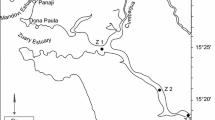Abstract
Plankton production in the Bay of Villefranche was relatively constant during March and April 1986 but the particle size at which the production occurred was more variable. At the beginning of the study, production was dominated by the larger (ca. 6 μm) flagellates but towards the end it was more or less equally divided between the nano- and picoplankton. There were considerable differences in the estimates of population growth rates, depending on the methods used, but on average the population doubling times were close to 12 hours for autotrophs and 24 hours for heterotrophs. As autotrophs do not grow during the night, each population was therefore doubling once per day. It seemed that each of the nanoor picoplankton populations could adversely affect the growth of the others. This could be either by simple predation or by some form of inhibition. Although nutrient levels in the bay were uniformly low, the addition of nutrients did not always stimulate algal growth. The plankton populations seemed to be both in a state of equilibrium and intense ecological competition.
Similar content being viewed by others
References
Anderson, G. C., T. R. Parsons & K. Stephens, 1969. Nitrate distribution in the northeast Pacific Ocean. Deep-Sea Res. 16:329–333.
Bjørnsen, P. K., 1986. Automatic determination of bacterioplankton biomass by image analysis. Appl. envir. Microbiol. 51: 1199–1204.
Blackburn, M., R. M. Laurs, R. W. Owen & B. Zeitschel, 1970. Seasonal and areal changes in standing stocks of phytoplankton, zooplankton and micronekton in the eastern tropical Pacific. Mar. Biol. 7: 14–31.
Davis, P. G. & J. McN. Sieburth, 1982. Differentiation of phototrophic and heterotrophic nanoplankton populations in marine waters by epifluorescence microscopy. Ann. Inst. Océanogr. (Paris) 58: 249–260.
Fuhrman, J. A. & F. Azam, 1982. Thymidine incorporation as a measure of heterotrophic bacterioplankton production in marine surface waters: Evaluation and field results. Mar. Biol. 66: 109–120.
Goldman, J. C. & M. R. Dennett, 1985. Susceptibility of some marine phytoplankton species to cell breakage during filtration and post-filtration rinsing. J. Exp. mar. Biol. Ecol. 86: 47–58.
Harris, G. P., F. B. Griffiths & D. P. Thomas, 1989. Light and dark uptake and loss of14C: methodological problems with productivity measurements in oceanic waters. Hydrobiologia 173: 95–105.
Hobbie, J. E., R. J. Daley & S. Jasper, 1977. Use of nuclepore filters for counting bacteria by epifluorescence microscopy. Appl. envir. Microbiol. 33: 1225–1228.
Jørgensen, E. G., 1962. Antibiotic substances from cells and culture solutions of unicellular algae with special reference to some chlorophyll derivatives. Physiol. Plant. 15: 530–545.
Karl, D. M. & O. Holm-Hansen, 1978. ATP, ADP and AMP determinations in water samples and algal cultures. In Handbook of phycological, physiological and biochemical methods: J. A. Hellebust & J. S. Craigie, Cambridge (eds): 197–206.
Koroleff, F., 1969. Direct determination of ammonia in natural waters as indophenol blue. Int. Cons. Explor. Mer. C. M. 1969/C: 9.
Lee,S. & J. D. Fuhrman, 1987. Relationships between biovolume and biomass of naturally derived marine bacterioplankton. Appl. Envir. Microbiol. 53: 1298–13030.
Li, W. K. W. & A. M. Wood, 1988. Vertical distribution of North Atlantic ultraplankton: analysis by flow cytometry and epifluorescence microscopy. Deep-Sea Res. 35: 1615–1638.
Neveux, J. & M. Panouse, 1987. Spectrofluorometric determination of chlorophylls and phaeophytins. Archiv. Hydrobiol. 109: 567–581.
Porter,K. G. & Y. S. Feig, 1980. The use of DAPI for identifying and counting aquatic microflora. Limnol. Oceanogr. 25: 943–948.
Prakash, A., R. W. Sheldon & W. H. Sutcliffe, Jr., 1991. Geographic variation of oceanic14C dark uptake. Limnol. Oceanogr. 36: 30–39.
Rassoulzadegan, F., 1978. Dimensions et taux d'ingestion des particules consommées par un tintinideFavella Ehrenbergii (Clap & Lachm) Jörg, cilié pélagique marin. Ann. Inst. Océanogr. (Paris) 54: 17–24.
Rassoulzadegan, F., 1982. Dependence of grazing rate, gross growth efficiency and food size range in a pelagic oligotrichous ciliateLohmanniella spiralis Leeg, fed on naturally occurring particulate matter. Ann. Inst. Océanogr. (Paris) 58: 177–184.
Rassoulzadegan, F. & M. Etienne, 1981. Grazing rate of the tintinidStenosomella ventricosa (Clap & Lachm) Jörg, on the spectrum of naturally occurring particulate matter from a Mediterranean neritic area. Limnol. Oceanogr. 26: 258–270
Rassoulzadegan, F., M. Laval-Peuto & R. W. Sheldon, 1988. Partitioning of the food ration of marine ciliates between pico- and nanoplankton. Hydrobiologia 159: 75–88.
Rassoulzadegan, F. & R. W. Sheldon, 1986. Predator-prey interactions of nanozooplankton and bacteria in an oligotrophic marine environment. Limnol. Oceanogr. 31: 1010–1021.
Rivier, A., D. C. Brownlee, R. W. Sheldon & F. Rassoulzadegan, 1985. Growth of microzooplankton: a comparative study of bactivorous zooflagellates and ciliates. Mar. Microb. Food Webs 1: 51–60.
Romano, J. C. & R. Daumas, 1981. Adenosine nucleotide ‘energy charge’ ratios as an ecophysiological index for microplankton communities. Mar. Biol. 62: 281–296.
Ryther, J. H., 1963. Geographic variations in productivity. In ‘The Sea’ vol. 2, pp. 347–380. Ed. M.N. Hill. Interscience.
Sheldon, R. W., A. Prakash & W. H. Sutcliffe, Jr., 1972. The size distribution of particles in the ocean. Limnol. Oceanogr. 17: 327–340.
Sheldon, R. W. & F. Rassoulzadegan, 1987. A method for measuring plankton production by particle counting. Mar. Microb. Food Webs 2: 29–44.
Sherr, E. B., B. F. Sherr & G. A. Paffenhöffer, 1986. Phagotrophic protozoa as food for metazoans: a missing link in marine pelagic food webs. Mar. Microb. Food Webs 1: 61–80.
Stockner, J. G. & N. J. Antia, 1986. Algal picoplankton from marine and freshwater ecosystems: a multidisciplinary perspective. Can. J. Fish. aquat. Sci. 43: 2472–2503.
Tréguer, P. & P. Le Corre, 1975. Manuel d'analyses des sets nutritifs dans l'eau de mer (utilisation de l'Autoanalyser II Technicon). Laboratoire d'océanographie chimique. Université de Bretagne. Brest. 110 pp.
Author information
Authors and Affiliations
Rights and permissions
About this article
Cite this article
Sheldon, R.W., Rassoulzadegan, F., Azam, F. et al. Nano- and picoplankton growth and production in the Bay of Villefranche sur Mer (N.W. Mediterranean). Hydrobiologia 241, 91–106 (1992). https://doi.org/10.1007/BF00008262
Received:
Revised:
Accepted:
Issue Date:
DOI: https://doi.org/10.1007/BF00008262



